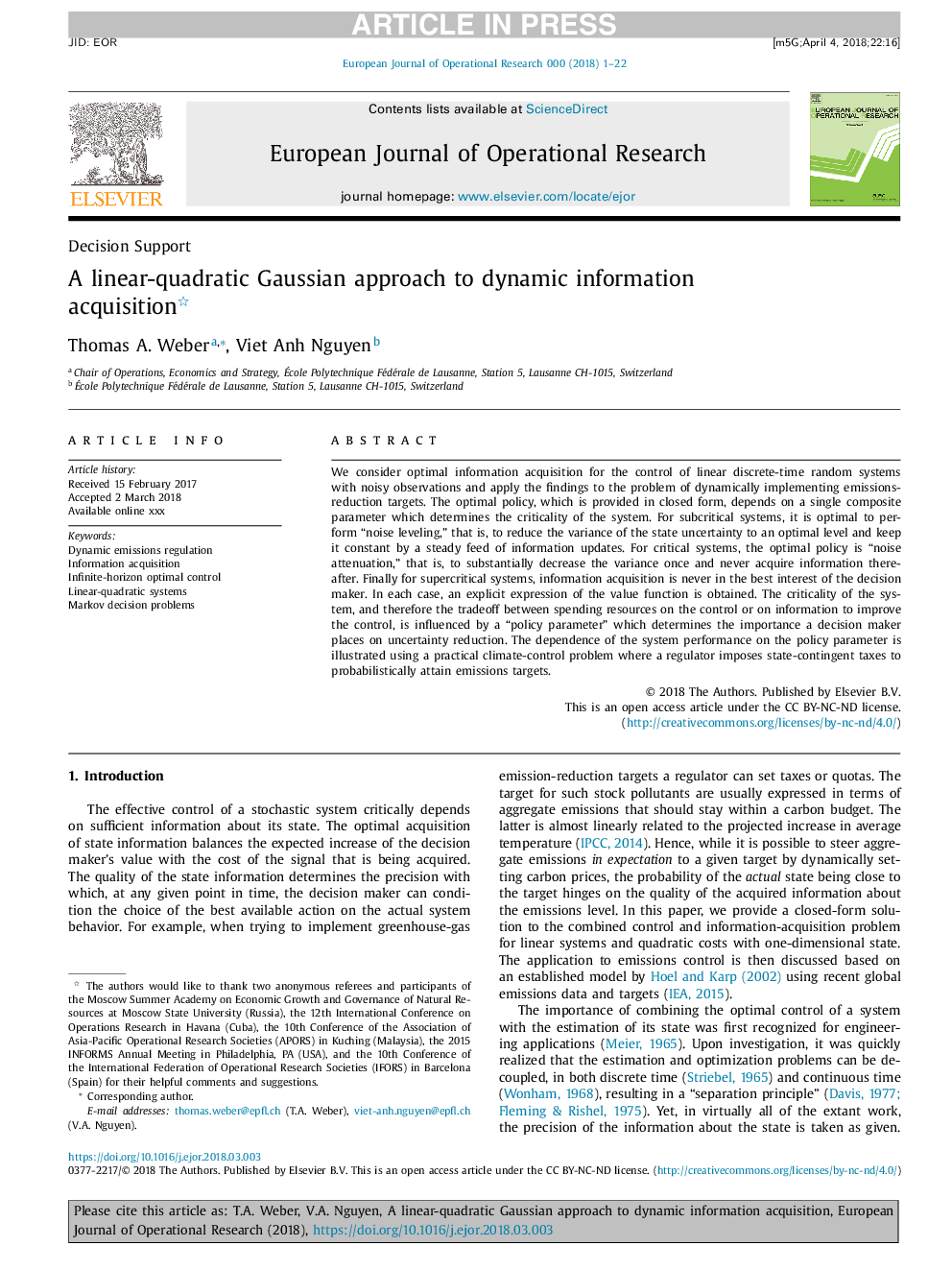| کد مقاله | کد نشریه | سال انتشار | مقاله انگلیسی | نسخه تمام متن |
|---|---|---|---|---|
| 6894642 | 1445927 | 2018 | 22 صفحه PDF | دانلود رایگان |
عنوان انگلیسی مقاله ISI
A linear-quadratic Gaussian approach to dynamic information acquisition
ترجمه فارسی عنوان
رویکرد گاوسی خطی-درجه دوم به کسب اطلاعات پویا
دانلود مقاله + سفارش ترجمه
دانلود مقاله ISI انگلیسی
رایگان برای ایرانیان
کلمات کلیدی
مقررات انتشار دینامیک، کسب اطلاعات، کنترل بهینه افق بی نهایت، سیستم های خطی-درجه دوم، مشکلات تصمیم گیری مارکوف،
ترجمه چکیده
ما برای به دست آوردن اطلاعات مطلوب برای کنترل سیستم های تصادفی با زمان گسسته خطی با مشاهدات پر سر و صدا استفاده می کنیم و یافته ها را به مشکل هدایت اهداف کاهش انتشار گازهای گلخانه ای می رسانیم. سیاست مطلوب، که در فرم بسته ارائه می شود، بستگی به یک پارامتر کامپوزیت دارد که بحرانی بودن سیستم را تعیین می کند. برای سیستم های زیرین کریستال، برای انجام یک سطح صدای ریز، بهینه است؟ یعنی، برای کاهش واریانس عدم قطعیت دولت به یک سطح بهینه و حفظ آن با یک جریان ثابت از به روز رسانی اطلاعات ثابت است. برای سیستم های بحرانی، سیاست مطلوب یک "ضعف صدا" است. بدین معنی است که واریانس را به میزان قابل توجهی کاهش دهیم و پس از آن هرگز اطلاعات را بدست نیاوریم. در نهایت برای سیستم های فوق بحرانی، کسب اطلاعات هرگز در بهترین منافع تصمیم گیرنده نیست. در هر مورد، بیان صریح تابع ارزش به دست می آید. بحرانی بودن سیستم و در نتیجه تجارت بین منابع هزینه بر کنترل و یا اطلاعات برای بهبود کنترل تحت تاثیر پارامترهای سیاست قرار می گیرد؟ که تعیین کننده اهمیت یک تصمیم گیرنده در کاهش نااطمینانی است. وابستگی عملکرد سیستم به پارامتر سیاست با استفاده از یک مشکل عملی کنترل آب و هوا که در آن یک تنظیم کننده مالیات های احتمالی دولت را به منظور دستیابی احتمالی به اهداف انتشار، تحمیل می کند، نشان داده شده است.
موضوعات مرتبط
مهندسی و علوم پایه
مهندسی کامپیوتر
علوم کامپیوتر (عمومی)
چکیده انگلیسی
We consider optimal information acquisition for the control of linear discrete-time random systems with noisy observations and apply the findings to the problem of dynamically implementing emissions-reduction targets. The optimal policy, which is provided in closed form, depends on a single composite parameter which determines the criticality of the system. For subcritical systems, it is optimal to perform “noise leveling,” that is, to reduce the variance of the state uncertainty to an optimal level and keep it constant by a steady feed of information updates. For critical systems, the optimal policy is “noise attenuation,” that is, to substantially decrease the variance once and never acquire information thereafter. Finally for supercritical systems, information acquisition is never in the best interest of the decision maker. In each case, an explicit expression of the value function is obtained. The criticality of the system, and therefore the tradeoff between spending resources on the control or on information to improve the control, is influenced by a “policy parameter” which determines the importance a decision maker places on uncertainty reduction. The dependence of the system performance on the policy parameter is illustrated using a practical climate-control problem where a regulator imposes state-contingent taxes to probabilistically attain emissions targets.
ناشر
Database: Elsevier - ScienceDirect (ساینس دایرکت)
Journal: European Journal of Operational Research - Volume 270, Issue 1, 1 October 2018, Pages 260-281
Journal: European Journal of Operational Research - Volume 270, Issue 1, 1 October 2018, Pages 260-281
نویسندگان
Thomas A. Weber, Viet Anh Nguyen,
